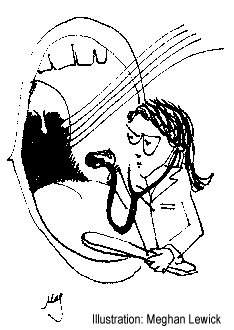Classifying Singing Voices by Dr. Françoise P. Chagnon
/ September 1, 1998
Version française...
 Voice classification
is a frequent preoccupation of young singers searching for
repertoire. Often, singers are sent to a laryngologist in the hope
that the anatomy of their vocal folds and throat will help in their
voice classification. The prevailing misconception among novices is
that vocal fold length determines voice type. However,
classification must also take into account voice quality and pitch
(perceived frequency) range, and not just the fundamental frequency
produced by the vibrating vocal folds. Voice classification
is a frequent preoccupation of young singers searching for
repertoire. Often, singers are sent to a laryngologist in the hope
that the anatomy of their vocal folds and throat will help in their
voice classification. The prevailing misconception among novices is
that vocal fold length determines voice type. However,
classification must also take into account voice quality and pitch
(perceived frequency) range, and not just the fundamental frequency
produced by the vibrating vocal folds.
In general, longer vocal folds in males (18 to 24 mm) than in
females (14 to 19 mm) correspond to deeper voices. Determining vocal
fold length by direct examination is not an easy task. One must
consider only the vibrating membranous part of the vocal fold and
account for variations in length due to vocal muscle contraction.
Varying vocal fold length is not the only factor determining higher
fundamental frequency in singing; changes in vocal muscle tension
are also involved.
The shape and volume of the resonating oral cavities are also
important since they give the colour to the voice. Theoretically,
for a given vocal fold length, the voice is perceived as darker
(lower) if the vocal tract is longer. To a certain extent, singers
can control the length of their resonating vocal tracts by raising
or lowering their larynx or pursing their lips.
Hence, voice classification must be based on dynamic
physiological parameters. There is currently no rigorous scientific
method to determine voice classification. However, there is
agreement on the following criteria:
1) The tessitura. This is the part of the vocal range which the
singer is most comfortable producing: for tenors, C3 to C5; for
baritones, A2 to A4; for basses, E2 to E4; for sopranos, C4 to C6;
for mezzo-sopranos, A3 to A5; for altos, E3 to G5.
2) The passaggio. This is the range of frequencies at which a
register change occurs: for tenors, E4 to F4; for baritones, D4 to
E4; for basses, C4 to D4. The passaggio for female voices is one
octave higher than in the male.
3) The overall spectrum of acoustic energy in the voice. Vocal
sound contains frequencies generated by the vocal folds that are
shaped into peaks (formants) by the resonating vocal tract.
Cleveland (1978) proposed a classification of the male singing voice
based on average spectral peaks of acoustic energy extracted from
the singing of an extended passage. Objective analysis of the
acoustic energy peaks allows for hybrid classifications that occur
when short vocal cords are coupled with a long vocal tract, or vice
versa.
The objective of classifying the voice is to steer singers
towards a repertoire that best suits their anatomical and
physiological potential. There is no need for premature
classification, as the inexperienced singer's tessitura and vocal
range are underdeveloped.
Voice
classification is best done by the vocal pedagogue. Laryngologists
may assist by correcting impeding vocal fold pathologies. Acoustical
analysis serves as a pedagogical aid by highlighting the importance
of modulation of the vocal tract resonators in formant development
and enrichment of the acoustical output. Ultimately, proper voice
classification follows from optimizing the singer's physical reality
through correct vocal training.
Version française... | 

